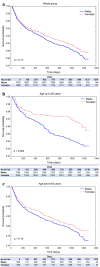Sex and other predictors of mortality in long-term follow-up of patients with cardiovascular disease and COVID-19: a single-center retrospective study
- PMID: 40246964
- PMCID: PMC12006295
- DOI: 10.1038/s41598-025-93402-w
Sex and other predictors of mortality in long-term follow-up of patients with cardiovascular disease and COVID-19: a single-center retrospective study
Abstract
Male sex is a well-known predictor of short-term prognosis in patients with coronavirus disease (COVID-19). Data, however, on long-term outcomes are scarce. We aimed to assess the differences in mortality between sexes and find other important predictors of survival from a long-term perspective. Data from all patients retrieved from a database of COVID-19 patients hospitalized at University Hospital in Krakow, Poland, between February 13, 2020, and May 10, 2021, were analyzed for clinical in-hospital data and after a 42 months follow-up period. Of the 4071 COVID-19 patients hospitalized, 2183 were men (53.6%). Males were on average younger and more likely to have concomitant chronic obstructive pulmonary disease, heart failure, coronary artery disease (including acute and chronic coronary syndrome) compared to women. In terms of laboratory findings, more advanced inflammatory markers and troponin I were predominantly observed in male patients than in female patients. Males were found to have a greater predisposition for relevant cardiovascular comorbidities and were more likely to have died during the 42 months follow-up. Additionally, higher levels of troponin I, N-terminal pro B-type natriuretic peptide and D-dimer were associated with a greater risk of death. Kaplan-Meier survival analyses revealed a worse 42 months survival for men up to the age of 65 years. Cardiovascular comorbidities, male sex and older age, as well as higher concentrations of markers indicating a thrombotic state and myocardial injury, were associated with poorer long-term prognosis in patients with COVID-19.
Keywords: COVID-19; Cardiovascular comorbidities; Outcome; Sex.
© 2025. The Author(s).
Conflict of interest statement
Declarations. Competing interests: The authors declare no competing interests. Ethics approval: The study was a retrospective analysis of the medical records of discharged patients and did not affect patient safety or the occurrence of possible complications, therefore obtaining consent from the study participants was not necessary. The study was conducted in accordance with the guidelines of the Declaration of Helsinki and with the aforementioned methodology was approved by the Bioethics Committee of Jagiellonian University in Krakow (Poland) (decision number 1072.6120.278.2020). The authors confirm that the obtaining of informed consent from the study participants was waived by the Bioethics Committee of the Jagiellonian University in Krakow (Poland). Consent for publication: Not applicable.
Figures






References
-
- Figliozzi, S. et al. Predictors of adverse prognosis in COVID-19: A systematic review and meta-analysis. Eur. J. Clin. Invest.50(10), e13362. 10.1111/ECI.13362 (2020). - PubMed
-
- Clerkin, K. J. et al. COVID-19 and cardiovascular disease. Circulation141(20), 1648–1655. 10.1161/CIRCULATIONAHA.120.046941/ASSET/869E6314-869F-4C2D-9F6D-87FF1087C3E0/ASSETS/IMAGES/LARGE/CIRCULATIONAHA.120.046941.FIG04.JPG (2020). - PubMed
MeSH terms
Substances
LinkOut - more resources
Full Text Sources
Medical

